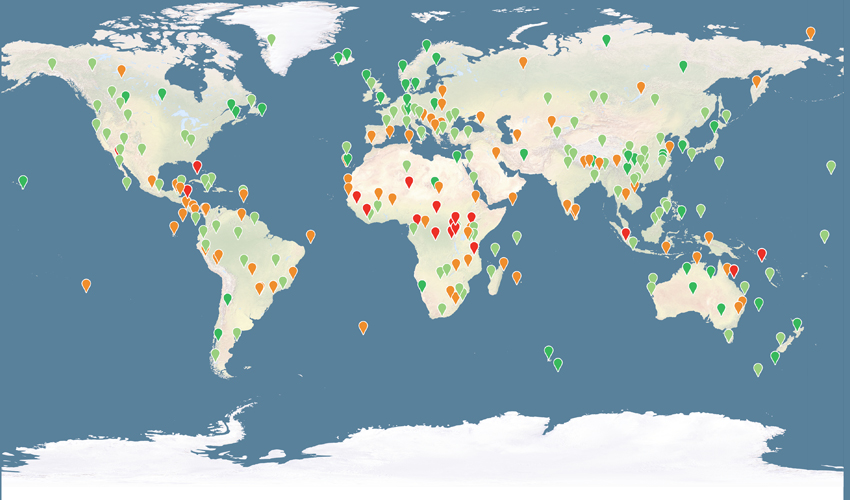The power of danger listing, hasty inscriptions, smarter financing and a voice for civil society – IUCN’s key takeaways from the 2017 World Heritage Committee meeting
As the 41stWorld Heritage Committee meeting closes today in Kraków, Poland, Tim Badman, Director of IUCN’s World Heritage Programme and head of the IUCN delegation at the Committee, shares his thoughts on how the meeting went this year.
The 41st session of the World Heritage Committee has just closed here in beautiful Kraków, Poland, and I am celebrating 10 years in IUCN’s World Heritage Programme, handling our unique and high-profile role as the World Heritage Convention’s official adviser on nature. IUCN’s hard-working and diverse delegation has finished its work after 10 days of intense debate. We’ve held 23 side events, many jointly with IUCN Members, where we have profiled our flagship work on the IUCN World Heritage Outlook, illegal wildlife trade, Key Biodiversity Areas, and more. We’ve also launched a new publication on Wilderness, a lab for World Heritage analyses and a major report on Rights-based approaches.
What are my take homes for nature conservation from this year’s meeting?
1 The Danger List can work
This year, we celebrated restored conservation status to Comoé National Park in Côte d’Ivoire, and (even if IUCN considered issues remain) Simien National Park in Ethiopia. Both sites were removed from the Convention’s List of World Heritage in Danger – or Danger List. The prospects of danger listing also galvanised major actions for the Cerrado Protected Areas in Brazil, and for the Gulf of California, where Mexico has launched an intense programme to try to save the desperate situation of the Critically Endangered vaquita.
These examples show the power of the Danger List as a positive conservation instrument, and we hope that similar results will be achieved for sites facing the prospect of danger listing in the coming year, including Poland’s own Białowieża Forest. But we also saw the confirmation that site level action is not enough to tackle the critical threats incoming to sites through climate change – a new policy for climate change and World Heritage will be prepared for 2018.
2 Great new sites, but in haste
We celebrated five new natural World Heritage sites, but the continued challenge of listing sites that don’t meet the World Heritage Convention’s requirements was again in evidence. Nine of the 21 new World Heritage sites (eight cultural and one natural) were not recommended for inscription by IUCN or our sister cultural advisory body ICOMOS.
Whilst we celebrate the conservation that will result, hasty listing does not benefit the Convention, or, in the long run, the States Parties who find themselves with monitoring missions and UNESCO reports. We should do better to hold the gold standard for World Heritage.
3 A smarter approach to financing World Heritage
Let’s talk about money. Less noticed than the decisions on eye-catching sites were the introduction of a new “market place” for World Heritage projects, and a decision to set up costed action plans for the List of World Heritage in Danger. A sharper act on building funding partnerships is also taking shape. The World Heritage Convention’s budget group taking place at the Committee usually offers little reassurance; but for once I am optimistic we might at last have some solutions to get finance to the World Heritage sites that need it most.
4 Opening the doors to civil society
Dr Jacek Purchla, the chair of the World Heritage Committee, presided with humour and unflappable calmness over the meeting here. He takes particular credit for giving civil society a voice like never before. NGOs and community representatives were heard consistently in the big hall. He also started a long overdue dialogue with civil society about how to open up the World Heritage Convention.
Poland also takes the laurels for holding the first World Heritage Site Managers Forum, and the Committee welcomed the establishment of an Indigenous Peoples Forum for World Heritage. This “glasnost” is what the Convention needs: to reach beyond the formality of the big conference centre and to the ground level where action happens.
Once upon a time, before I worked for IUCN, I was a World Heritage site manager, a role I occupied for 10 years. After going through the hard work of preparing a nomination (and getting grilled by IUCN before our site was recommended for inscription), we concluded a secret of success was “naïve optimism”. So here in Kraków, after a decade in the IUCN World Heritage hot seat, let me close out as a continued, if less naïve, optimist about the future of World Heritage – and our shared and most exceptional natural and cultural places.
Dziękuję Ci to Dr Purchla and his team, Kraków and Poland.
See you next year!





